- Bernard Preston homepage
- Yellows
- Buttered Gem Squash
Buttered gem squash
Buttered gem squash are my favourite summer crop. They are not difficult to grow but late in the season they get stung; that's difficult for us as we refuse to spray toxic poisons on our food.
So early in the season we enjoy gem and zucchini squash, later it's pumpkins and butternut.
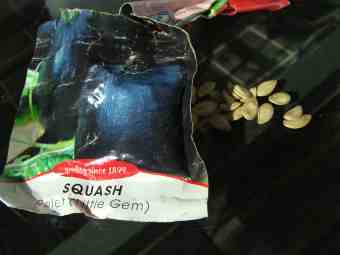
This page was last updated by Bernard Preston on 14th May, 2023.
Growing gem squash
How to cook gem squash
How to make gem squash
Making a compost pile
Phytochemicals
Vervet monkeys
One of the things I love about SBI, the web builder that I use, is that they tell me what keywords folk like you are searching for. Astonishingly, there is almost no one looking for any information whatsoever about these little beauties; I write because they are definitely one of our favourites for the summer garden. Easy to grow, bear before Christmas in the southern hemisphere, and are prolific.
One significant problem; in our neck of the woods the vervet monkeys are equally enamoured. Farmer Brown is busy getting paint ball gun practice; it stings but doesn't maim or kill.
They will grow on the ground, but they are really climbers. Getting the fruit off the earth is not unimportant; you can use a natural barrier like the bamboo below, create a trellis or easiest of all a garden fence.
Ours have to compete; you'll see both tomatoes and pole beans fighting for light on the same fence. A bit of competition never does any harm unless you're growing veggies commercially and want to maximise on light, nutrition and water.
Like zucchini squash, gems are one of the few vegetables and fruits that have both lutein and zeaxanthin, the two phytochemicals that prevent adult onset blindness. Want to retain your sight when you get old and grey? Enjoy these summer squash.
Growing gem squash
Growing gem squash starts with a packet of seeds; these are gems in more ways than one. My favourite summer squash in terms of flavour and sweetness; add a dab of butter and you have the perfect veg to go with your protein.
I haven't looked up the glycemic index, but I'm certain it's low. Buttered gem squash would even be fine if you're banting.
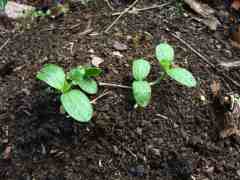
The seedling grow very fast; what's interesting is that some seeds are always laggards; I'll pull out the two miseries you can see here. Always plant at least three seeds in a heap and thin them later.
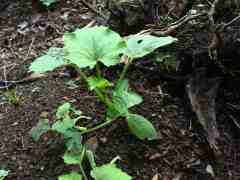
Gems will climb any natural barrier, like this bamboo.
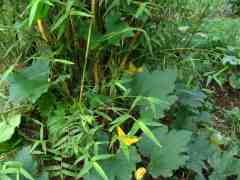
Or you can grow them on a fence like this. I tend to keep the fences for legumes, peas in the winter and pole beans and limas in the summer; but it's good to rotate the crop. Notice how green these gem squash leaves are from all the nitrogen stored from the nitrogen fixation bacteria in last winter's green pea roots.

And now for the first fruit; they are prolific bearers, gems in more ways than one. Can you spot five baby gem squash in the pic above?
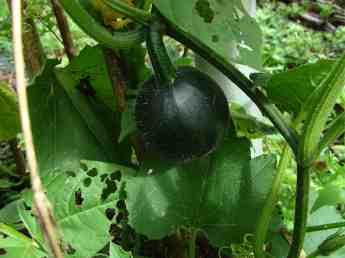
How to cook gem squash
Don't wait for your gem squash to get hard skins; the flesh tends to get woody and the pips very hard. That's often the way you'll find them in the green grocer, and perhaps why folk don't like the fruit. Even then, how to cook gem squash ain't difficult.
But straight from the garden, you can eat them skin, pips and all; absolutely delicious.
There's no need to pressure cook your young gem squash; just pop them into a pot, add a tablespoon or three of boiling water and turn the heat up on high for about five minutes, or until a sharp knife penetrates the skin and flesh easily. Steaming preserves the nutrients best of all.
Have you one of those new countertop induction stoves? They are gems too, using less than half the electricity and heating faster than gas; only you must have a steel or caste iron pot.
Copper-bottomed and aluminium pots are no good. Buttered gem squash, here we come.
Although a few of your gem squash may be stung by fruit fly, one can generally cut out the offending part; there is certainly no necessity for spraying them with toxic poisons.
This is particularly important as the skins are even more rich than the flesh in the phytochemicals lutein and zeaxanthin, and so excellent for the eyes.
Interestingly they are particularly high in pectin too, the same starch in apples, for example, that helps regulate the large intestine, and reduce surges in blood sugar. It's good stuff for diabetics in particular.
Buttered gem squash
Buttered gem squash are even tastier than zucchinis but both are rich in anti oxidants.
Today I will pick a couple fruit for dinner, and then we can get on to the heart of this page; butter gem squash that excels in South Africa, and in any moderate summer climate.
Notice the essence of the complete dinner. On this page, pride of place goes to the buttered gem squash, of course; that's where most of the carbohydrate is. Gem squash have a low glycemic index anyway, but add a dab of butter and you need have no qualms if you are banting.
Fibre
Gem squash are a rich source of fibre; 3g in each fruit. Only 5% of those on a typical grocery store meal-plan are getting the required amount, making a massive contribution to unwellness.
Newsletter
Our newsletter is entitled "create a cyan zone" at your home, preserving both yourself and Mother Earth for future generations; and your family too, of course. We promise not to spam you with daily emails promoting various products. You may get an occasional nudge to buy one of my books.
Here are the back issues.
- Investing in long-term health
- Diseases from plastic exposure
- Intensive lifestyle management for obesity has limited value
- A world largely devoid of Parkinson's Disease
- The impact of friendly bacteria in the tum on the prevention of cancer
- There's a hole in the bucket
- Everyone is talking about weight loss drugs
- Pull the sweet tooth
- If you suffer from heartburn plant a susu
- Refined maize meal and stunting
- Should agriculture and industry get priority for water and electricity?
- Nature is calling
- Mill your own flour
- Bake your own sourdough bread
- Microplastics from our water
- Alternative types of water storage
- Wear your clothes out
- Comfort foods
- Create a bee-friendly environment
- Go to bed slightly hungry
- Keep bees
- Blue zone folk are religious
- Reduce plastic waste
- Family is important
- What can go in compost?
- Grow broad beans for longevity
- Harvest and store sunshine
- Blue zone exercise
- Harvest and store your rainwater
- Create a cyan zone at your home
Fresh buttered green beans are the perfect foil to the sausage and pork spare ribs; they contain some carbohydrate too, but are high in vegetable protein, making them a true phytochemical food. Overall there are plenty of amino acids, with or without the meat.
Then there's the butter, and some animal lard in the meat; add to that the olive oil dribbled over the Greek salad, and you have plenty of fat to lower the glycemic index of the overall meal.
Very important new research confirms that there is absolutely no scientific basis to replacing animal fat with margarine; in short, butter is back. Thank goodness, I've always had an intrinsic dislike of hydrogenated oils.
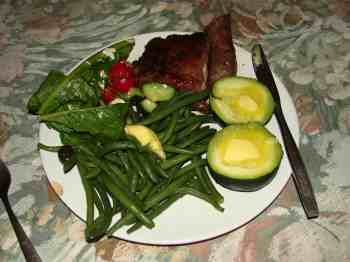
The salad has several different varieties of lettuce, fresh from the
garden, baby tomatoes and olives and it's smothered in my favourite
condiment; homemade recipe basil pesto is quick. It takes less than five minutes to rustle up. There is a tablespoon of hummus lurking there somewhere.
This buttered gem squash dinner makes up the perfect modified banting food plan; the queen of England did not eat more delicious and nutritious food last night, and the presidents of America and South Africa certainly did not. Nor did their dinner taste anywhere near as good.
Find the links to those topics highlighted in bold by copying and pasting into the Site Search function in the navigation bar on your left.
How to make gem squash
One traditional way to enjoy your gem squash is to cut them in half and then boil them for a few minutes. This is especially good if they are slightly older; the pips and skin are hard and should be discarded. How to make gem squash is not kitchen rocket science! Just a dab and you have heavenly buttered gem squash.
There is a little balance to find for your own tastebuds; too young and they are a little insipid. Too old and they become starchy and tasteless. In between, the yellow colour of the beta carotene and flavour maximises, without sacrificing the pips which should still be tender and delicious.
More about a beta carotene deficiency at the bottom of this page.
Another way is to spear your gem squash with a sharp knife and then microwave them for about two minutes each. I still do not see unequivocal evidence suggesting this way of preparing food is bad for us; I am open to being convinced.
Making a compost pile
Making a compost pile is admittedly hard work; limber up first or you'll be keeping your chiropractor in business! The very best crop for your buttered gem squash grow in deep humus; they are heavy feeders. Getting your garden soil ready is an essential part of growing strong gem squash plants.
Pride of place in the green garden is taken by the compost pile; if you want really nutritious and delicious buttered gem squash, start cultivating your kitchen scraps, but nothing that's been cooked.
Every home should have compost bins gardening; gem skins are perfect, particularly if they first go via the worm farm.
Weeds and grass cuttings too are wonderful. Making a compost pile should be high on your list of priorities; it makes for the vibrant organic garden, and is the simplest way of disposing of your waste.
- Making a compost pile or heap
Your kitchen waste could even better be used to feed a worm farm. The greedy little monsters need a lot of food, and then you can add them to your compost pile.
Phytochemicals
Phytochemicals are the wonderful smells and flavours in garlic, sweet basil and parsley; buttered gem squash are loaded with them; more important is their simply vast nutritional benefits.
The bioflavonoids in fruit and vegetables are of vital importance to our well-being, yet there are so many and so little is actually proven scientific fact. They are known to have antioxidant properties, so they mop up tumour-causing free radicals, lower our cholesterol and keep our arteries clean. They are almost certainly part of the reason why those who enjoy coloured foods have less senile dementia.
These phytochemical foods are every day treats like grapes, blue berries, apples, tea, broccoli and parsley.
Your summer squash like gems and zucchinis are particularly rich in the carotenes, lutein and zeaxanthin which are exceptionally important for the eyes. There would be fewer car accidents if we all ate more phytochemicals.
- Lutein benefit
- Zeaxanthin macular degeneration[1]
Choice foods
There are so many reasons to make sure that choice foods are daily on the menu. As one wag said, if you don't look after your bod where are you planning to live? Buttered gem squash and zucchini should be on the menu right through the summer, several times a week. They are so easy to grow.
Vervet monkeys
Whilst there are some who make a case for a coexistence of humans and vervet monkeys, to my mind they are vermin. They attack our pets without warning, decimate our gardens and venture into our kitchens stealing fruit; and terrorising small children. In particular they love not yet buttered gem squash.
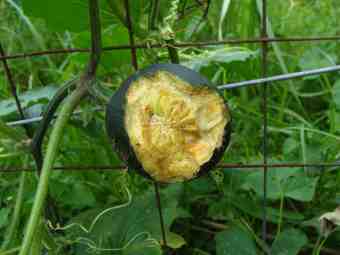
My particular dislike of them is their wasteful nature; they take one hap out of a gem before moving on to the next, making sure that neither we nor any competing troop can enjoy the fruit. They pull baby vegetable plants out of the ground and cause general mayhem. Without apology, they get the paintball treatment.
In particular they can devastate a whole crop of baby corn, taking one bite of each immature fruit before throwing it down and moving on to the next plant.
The paintball gun neither kills nor maims them; but it does sting, and they soon get the message. You are not welcome!
Here's a little tip for paintball gun owners; the balls need to be kept in an airtight container, or they go soft and burst in the barrel; or in the freezer.
For reasons unknown to me, the vervets have no interest in another of my favourites; thus growing zucchini may be a better option for you if you're plagued by the monkeys.
Chickens in the garden too love buttered gem squash but they don't disturb the plants or peck at the fruit until it is cooked.
Keep back some of the seed; dry them on newspaper and pop them into an old envelope, clearly labelled for next year.
Gem squash recipes
We will get to these recipes later when the fruit gets a little older. Right now we simply enjoy buttered gem squash; it is without equal.
I'm just in the process of upgrading this page; and found that we so love plain buttered gem squash that we have not sought any new recipes.
This is all part of what I call the green journey; more of a spiritual voyage into the inner self really. It's all about discovering greater wellness, having fun and ensuring we leave our children a habitable planet.
Making new gem squash recipes is just one part of the journey; truth be told, plain buttered gem squash are so good; and because we are committed to simple basic cooking, we just haven't found a need to find new ways to prepare them. Accepting that we must all wean off plastic is a subject we each and everyone must contribute to.
Useful links
- Zeaxanthin macular degeneration Web: https://bit.ly/2Smnx32
- Phytochemical Foods
- Lutein and AMD
When browsing use right click and "Open Link in New Tab" or you may get a bad gateway signal.
Did you find this page interesting? How about forwarding it to a friend, or book and food junkie? Better still, a social mead tick would help.
- Bernard Preston homepage
- Yellows
- Buttered Gem Squash
Address:
56 Groenekloof Rd,
Hilton, KZN
South Africa
Website:
https://www.bernard-preston.com